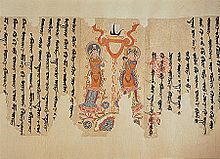
Back Sogdiese alfabet Afrikaans Согдийска азбука Bulgarian Alfabeto sogdiano Spanish الفبای سغدی Persian Alphabet sogdien French Szogd ábécé Hungarian Abjad Sogdi ID Alfabeto sogdiano Italian ソグド文字 Japanese 소그드 문자 Korean
| Sogdian *s{əγ}ʷδī́k ᵊzβā́k, *s{əγ}ʷδyā́u̯, 𐼑𐼇𐼄𐼌𐼊𐼋 [*𐼀𐼈𐼂𐼀𐼋] swγδyk [*ʾzβʾk] 𐼼𐼴𐼶𐼹𐼷𐼸 (𐼰𐼵𐼱𐼰𐼸) swγδyk (ʾzβʾk) 𐼼𐼲𐼴𐼹𐼷𐼰𐼴 sγwδyʾw 𐫘𐫇𐫄𐫔𐫏𐫀𐫇 swγδyʾw | |
|---|---|
 | |
| Script type | |
Time period | Late Antiquity |
| Direction | Horizontal and vertical writing in East Asian scripts, top-to-bottom Vertical (left-to-right); Horizontal (right-to-left) |
| Languages | Sogdian |
| Related scripts | |
Parent systems | |
Child systems | |
| ISO 15924 | |
| ISO 15924 | Sogd (141), Sogdian (Sogdian)Sogo (142) (Old Sogdian) |
| Unicode | |
Unicode alias | Sogdian |
| |
The Sogdian alphabet was originally used for the Sogdian language, a language in the Iranian family used by the people of Sogdia.[1] The alphabet is derived from Syriac, a descendant script of the Aramaic alphabet. The Sogdian alphabet is one of three scripts used to write the Sogdian language, the others being the Manichaean alphabet and the Syriac alphabet.[1] It was used throughout Central Asia, from the edge of Iran in the west, to China in the east, from approximately 100–1200 A.D.[1]
- ^ a b c Gharib, B. (1995), Sogdian Dictionary: Sogdian-Persian-English, Tehran, Iran: Farhangan Publications, xiii–xxxvi, ISBN 964-5558-06-9